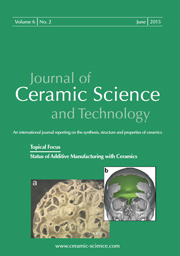Articles
All articles | Recent articles
Manufacturing of SiO2-Coated β-TCP Structures by 3D Printing using a Preceramic Polymer as Printing Binder and Silica Source
R. de Melo Bernardino1, C. Wirth2, S.L. Stares3, G.V. Salmoria1, D. Hotza2, J. Günster4
1 Laboratory of Innovation on Additive Manufacturing and Molding (NIMMA), Federal University of Santa Catarina (UFSC), 88040 – 900 Florianópolis, SC, Brazil
2 Siemens AG, Huttenstr. 12, D-10553 Berlin, Germany
3 Interdisciplinary Laboratory for the Development of Nanostructures (LINDEN), Federal University of Santa Catarina (UFSC), 88040 – 900 Florianópolis, SC, Brazil
4 Federal Institute for Materials Research and Testing (BAM), Ceramic Processing and Biomaterials, D-12203 Berlin, Germany
received July 16, 2017, received in revised form September 20, 2017, accepted October 10, 2017
Vol. 9, No. 1, Pages 37-42 DOI: 10.4416/JCST2017-00056
Abstract
Tricalcium phosphate (β-TCP) can be used as bone graft, exhibiting suitable bioabsorption and osteoconduction properties. The presence of silica may induce the formation of a hydroxyapatite layer, enhancing the integration between implant and bone tissue. Preceramic polymers present silicon in their composition, being a source of SiO2 after thermal treatment. Using the versatility of 3D printing, β-TCP and a polysiloxane were combined to manufacture a bulk β-TCP with a silica coating. For the additive manufacturing process, PMMA powder was used as passive binder for the β-TCP particles, and polymethylsilsesquioxane (MK), dissolved in an organic solvent, was used both as a printing binder (ink) and as the source of SiO2 for the coating. Five distinct coating compositions were printed with increasing amounts of MK. The structures were then submitted to heat treatment at 1180 °C for 4 h. XRD and FTIR showed no chemical reaction between the calcium phosphate and silica. SEM allowed observation of a silicon-based coating on the structure surface. Mechanical strength of the sintered porous structures was within the range of that of trabecular bones.
![]() Download Full Article (PDF)
Download Full Article (PDF)
Keywords
Tricalcium phosphate, three-dimensional printing, preceramic polymer, bone regeneration
References
1 Dorozhkin, S.V.: Biphasic, triphasic and multiphasic calcium orthophosphates, Acta Biomater., 8, [3], 963 – 977, (2012).
2 Pillai, R.S., Sglavo, V.M.: Effect of MgO addition on solid state synthesis and thermal behavior of beta-tricalcium phosphate, Ceram. Int., 41, [2], 2512 – 2518, (2015).
3 Horowitz, R.A., et al.: β-tricalcium phosphate as bone substitute material: properties and clinical applications, J. Osseointegration, 2, [2], 61 – 68, (2010).
4 Hench, L.L., Thompson, I.: Twenty-first century challenges for biomaterials, J. R. Soc. Interface, 7, 379 – 391, (2010).
5 Elsayed, H., et al.: Development of bioactive silicate-based glass-ceramics from preceramic polymer and fillers, J. Eur. Ceram. Soc., 35, [2], 731 – 739, (2015).
6 Elsayed, H., et al.: Hardystonite bioceramics from preceramic polymers, J. Eur. Ceram. Soc., 36, [3], 829 – 835, (2016).
7 Greil, P.: Polymer derived engineering ceramics. Adv. Eng. Mater., 2, [6], 339 – 348, (2000).
8 Sanson, O.: Preceramic polymer-derived ceramic scaffolds by 3D-printing. Universitá Degli Studi di Padova, PhD Thesis, 2014.
9 Zocca, A., et al.: SiOC ceramics with ordered porosity by 3D-printing of a preceramic polymer, J. Mater. Res., 28, [17], 2243 – 2252, (2013).
10 Colombo, P., et al.: Polymer-derived ceramics: 40 years of research and inovation in advanced ceramics, J. Am. Ceram. Soc., 93, [7], 1805 – 1837, (2010).
11 Callister, Jr, W.D., Rethwisch, D.G.: Materials science and engineering: An introduction. 9th ed. New York, Wiley, 2014.
12 Colombo, P., et al.: Additive manufacturing techniques for fabricating complex ceramic components from preceramic polymer, Am. Ceram. Soc. Bull., 96, [3], 16 – 23, (2016).
13 Liu, F.H.: Synthesis of biomedical composite scaffolds by laser sintering: mechanical properties and in vitro bioactivity evaluation, Appl. Surf. Sci., 297, 1 – 8, (2014).
14 Liu, F.H., Shen, Y.K., Lee, J.L.: Selective laser sintering of a hydroxyapatite-silica scaffold on cultured MG63 osteoblasts in vitro, Int. J. Precis. Eng. Man., 13, [3], 439 – 444, (2012).
15 Chartier, T., et al.: Additive manufacturing to produce complex 3D ceramic parts. J. Ceram. Sci. Tech., 6, [2], 95 – 104, (2015).
16 Carr, R.L.: Evaluating flow properties of solids. Chem. Eng., 72, [2], 163 – 168, (1965).
17 Stares, S.L., et al.: Paper-derived β-TCP. Mater. Lett., 98, 161 – 163, (2013).
18 Danzer, R., Supancic, P., Harrer, W.: Biaxial tensile strength test for brittle rectangular plates, J. Ceram. Soc. Japan, 114, [11], 1054 – 1060, (2006).
19 Zocca, A., et al.: 3D-printed silicate porous bioceramics using a non-sacrificial preceramic polymer binder, Biofabr., 7, 1 – 12, (2015).
20 Ananth, K.P., Shanmugam, S., Jose, S.P., Nathanael, A.J., Oh, T.H., Mangalaraj, D., Ballamurugan, A.M.: Structural and chemical analysis of silica-doped β-TCP ceramic coating on surgical grade 316L SS for possible biomedical application, J. Asian. Cer. Soc, 3, [3], 317 – 324, (2015).
21 Ma, Q., Ma, Y., Chen, Z.: Fabrication and characterization of nanoporous SiO2 ceramics via pyrolysis of silicone resin filled with nanometer SiO2 powders, Ceram. Int., 36, [8], 2269 – 2272, (2010).
22 Kopani, M., Mikula, M., Takahashi, M., Rusnák, J., Pinčik, E.: FT IR spectroscopy of silicon oxide layers prepared with perchloric acid, Appl. Surf. Sci., 269, 106 – 109, (2013).
23 Salmoria, G.V., Leite, J.L., Paggi, R.A.: The microstructural characterization of PA6/PA12 blend specimens fabricated by selective laser sintering. Pol. Testing, 28, [7], 746 – 751, (2009).
24 Karageorgiou, V., Kaplan, D.: Porosity of 3D biomaterial scaffolds and osteogenesis. Biomater., 26, [27], 5474 – 5491, (2005).
25 Hulbert, S.F., Morrison, S.J., Klawitter, J.J.: Tissue reaction to three ceramics of porous and non-porous structures, J. Biomed. Mater. Res., 6, [5], 347 – 374, (1972).
26 Hollister, S.J.: Porous scaffold design for tissue engineering, Nat. Mater., 4, 518 – 524, (2005).
27 Liao, H.T., et al.: Fabrication of tissue engineered PCL scaffold by selective laser-sintered machine for osteogenesis of adipose-derived stem cells, Virtual Phys. Protyp., 6, [1], 57 – 60, (2011).
28 Sudarmadji, N., et al.: Investigation of the mechanical properties and porosity relationships in selective laser-sintered polyhedral for functionally graded scaffolds, Acta Biomater., 7, [2], 530 – 537, (2011).
29 Shuai, C., et al.: Optimization of TCP/HAP ratio for better properties of calcium phosphate scaffold via selective laser sintering, Mater. Charact., 77, 23 – 31, (2013).
30 Yang, S., et al.: The design of scaffolds for use in tissue engineering: Part I.: Traditional factors, Tissue Eng., 7, [6], 679 – 689, (2004).
31 Hao, L., Lawrence, J., Chian, K.S.: Effects of CO2 laser irradiation on the surface properties of magnesia-partially stabilised zirconia (MgO-PSZ) bioceramic and the subsequent improvements in human osteoblast cell adhesion. J. Biomater. Appl., 19, 81 – 105, (2004).
32 Hollister, S.J., Maddox, R.D., Taboas, J.M.: Optimal design and fabrication of scaffolds to mimic tissue properties and satisfy biological constraints, Biomater., 23, [20], 4095 – 4103, (2002).
33 Cowin, S.C.: Bone mechanics handbook, 2nd ed. Boca Raton, CRC Press, 2001.
34 Jameson, J.R.: Characterization of bone material properties and microstructure in osteogenesis imperfecta/brittle bone disease, Marquette University, PhD Thesis, 2014.
Copyright
Göller Verlag GmbH


